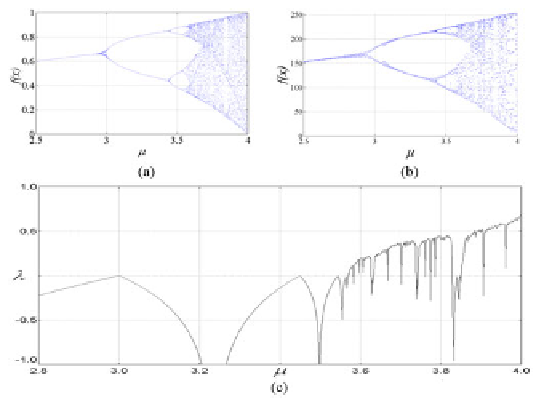Information Technology Reference
In-Depth Information
represents the module 2 bit to bit sum considering words of 8 bits. Each round
i
is
controlled by an 8 bytes sub-key
z
i-1, k-1
and each function
f
j
has the form
f
j
=(x
0
,…,x
j
,
z
j
)
and generate noise that will be applied in each round to each plaintext sub-block.
2.2 Use of Logistic Map
The logistic map is a chaotic system that generates sequences that exhibit a reproducible
chaotic behavior. Moreover, using the bifurcation diagram and Lyapunov exponent (see
Fig 1), the disadvantages of logistic map can be shown when it is used in cryptographic
systems. These disadvantages are the presence of stability islands, in which the logistic
map produces periodic signals into the chaotic region. This condition occurs when
λ
≤
0
(see Fig 1a), but when
0 the logistic map will produce aperiodic signals. These
stability islands appear according to Charkovsky sequence [8].
λ
≥
Fig. 1.
Behavior of logistic map. a) Bifurcation diagram in
ℜ
, b) Bifurcation diagram in
ℵ
(scaled and discretized logistic map) and c) Lyapunov exponent in
ℜ
.
2.3 Use of Piecewise Linear Maps
There are other 1-D chaotic maps that do not have stability islands and consequently
they do not produce periodic signals into the chaotic region. These 1-D chaotic maps
can be used as noise functions in cryptosystems, and they are known as piecewise
linear maps. Examples of these maps are Bernoulli and Tent maps. When these maps
are scaled and discretized, a non chaotic map is obtained, and the periodicity evidence
can be obtained using its bifurcation diagram (see Fig. 2). Note that when an 8 bits
precision is used in the tent map, the interval [0, 255] is not covered by the bifurcation
diagram. There are few bands in which the energy is concentrated (see Fig 2a). In Fig
2c the statistical distribution of tent map is shown when
μ
= 0.8, which is congruent
with Fig. 2a. However, when the 16 bits precision is used in the tent map, the bifurca-
tion diagram and statistical distribution is better respect to the 8 bits precision alterna-
tive (see Fig. 2b and 2d).

Search WWH ::

Custom Search